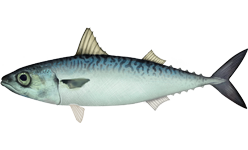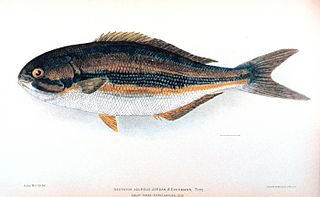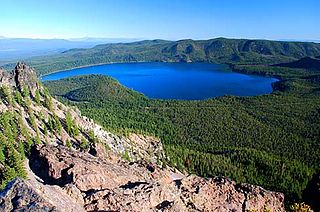
The chub mackerel, Pacific mackerel, or Pacific chub mackerel is a species of fish in the tuna and mackerel family, Scombridae. This species of mackerel closely resembles the Atlantic chub mackerel.

Gila is a genus of fish belonging to the family Cyprinidae, native to the United States and Mexico. Species of Gila are collectively referred to as western chubs. The chiselmouth is a close relative, as are members of the genus Siphateles. Several members of the genus are endangered or extinct due to loss of habitat causing by diversion or overuse of water resources, particularly in the western United States.

The Oregon chub is a species of ray-finned fish in the family Cyprinidae. It is endemic to Oregon in the United States. From 1993 to 2015 it was a federally listed threatened species.

Semotilus is the genus of creek chubs, ray-finned fish in the family Cyprinidae. The term "creek chub" is sometimes used for individual species, particularly the common creek chub, S. atromaculatus. The creek chub species of minnows can grow from 6 to 10 inches. They can be found in the United States and Canada in any small stream or creek. They hide under small rocks for protection. They have a small black spot on the dorsal fin for easy identification.
Squalius is a genus of fish in the family Cyprinidae found in Europe and Asia. Hybridization is not rare in the Cyprinidae, including this genus. S. alburnoides is known to be of ancient hybrid origin, with the paternal lineage deriving from a prehistoric species related to Anaecypris; the latter mated with ancestral S. pyrenaicus. Present-day S. alburnoides mates with sympatric congeners of other species.

Chub is a common fish name. It pertains to any one of a number of ray-finned fish in several families and genera. In the UK, the term chub usually refers to the species Squalius cephalus. In addition, see sea chub.

Diamond Lake is a natural body of water in the southern part of the U.S. state of Oregon. It lies near the junction of Oregon Route 138 and Oregon Route 230 in the Umpqua National Forest in Douglas County. It is located between Mount Bailey to the west and Mount Thielsen to the east; it is just north of Crater Lake National Park.

East Lake is one of the twin lakes that occupy part of the Newberry Crater or caldera in Central Oregon, United States. It is located in the Deschutes National Forest near the city of La Pine. The caldera was formed over 500,000 years ago from volcanic eruptions. East Lake's water comes from snow melt, rainfall, and hot springs only. The average depth is 67 feet (20 m), 180 feet (55 m) at the deepest point, and covers 1,044 acres (4.2 km2). East Lake is about 50 feet (15 m) higher in elevation and is to the east of its twin, Paulina Lake.

Paulina Lake is one of the twin crater lakes in Newberry Crater, central Oregon, United States. It is located 6,331 feet (1,930 m) above sea level in the Newberry National Volcanic Monument near La Pine. The lake's primary inflow is seepage from East Lake, snow melt, and hot springs, and its outflow is Paulina Creek, a tributary of the Little Deschutes River. It has an area of 1,531 acres (619.6 ha), a volume of 249,850 acre-feet (308,185 dam3), a maximum depth of 250 feet (76.2 m), a shore length of about 6.7 miles (11 km), and a residence time of about 46 years. The lake is classified as mesotrophic, with a transparency of approximately 13.1 feet (3.99 m). It is about 40 feet (12 m) lower and one mile west of its twin, East Lake.

Leuciscinae is a subfamily of the freshwater fish family Cyprinidae, which contains the true minnows.

Borax Lake is a 10-acre (4.0 ha) alkaline lake in the Alvord Desert of southeastern Oregon in the United States. The lake is fed by geothermal springs 100 feet (30 m) below the surface that range in temperature from 104 to 300 °F. Surface water temperatures usually range from 61 to 100 °F but occasionally go higher. The springs lie along the Steens fault zone, which runs north–south through the Alvord Valley east of Steens Mountain.

The Summer Lake Wildlife Area is a 29.6-square-mile (77 km2) wildlife refuge located on the northwestern edge of the Great Basin drainage in south-central Oregon. It is administered by the Oregon Department of Fish and Wildlife. The refuge is an important stop for waterfowl traveling along the Pacific Flyway during their spring and fall migrations. The Summer Lake Wildlife Area also provides habitat for shorebirds and other bird species as well as wide variety of mammals and several fish species. The Ana River supplies the water for the refuge wetlands.
Siphateles is a genus of fish belonging to the family Cyprinidae, native to the Western United States. They were formerly placed in the genus Gila.

Pogonichthyinae is a subfamily of the freshwater fish family Leuciscidae, which contains the true minnows. Members of this family are known as American minnows or the North American (NA) clade of minnows. As the name suggests, all members of this family are found in North America (although they are not the only minnows native to North America, as Plagopterinae, Laviniinae, and Leuciscinae are also found there).

Oregon & Northern California Coastal is a freshwater ecoregion in western North America. It includes the coastal rivers of Oregon and Northern California, from the Columbia River mouth in northwestern Oregon to northern Monterey Bay in Central California. It includes the Umpqua, Rogue, Smith River, Klamath, Mad, Eel, and lower Russian rivers, and many smaller coastal rivers and streams, including those on the coast side of the Marin and San Francisco peninsulas.
Frank Cramer was an American writer, biologist and educator.

The darkblotched rockfish is a species of marine ray-finned fish, a rockfish belonging to the subfamily Sebastinae of the scorpionfish family Scorpaenidae. This is a deepwater species of the North Pacific Ocean.














